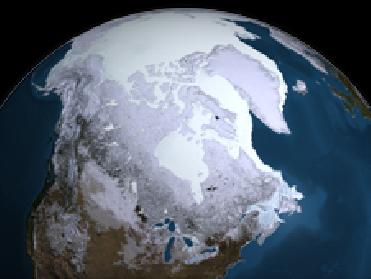
This data visualization image shows the maximum sea ice extent for 2008-09, which occurred on Feb. 28, 2009. Photo Credit: NASA
WASHINGTON (BNS): Continuing its decade-long trend of decay, the Arctic sea ice has been shrinking and the ice cap is also thinning, according to latest data released by NASA and the National Snow and Ice Data Center.
Scientists tracking the Arctic sea ice cover from space revealed that this winter recorded the fifth lowest maximum ice extent. The six lowest maximum events since satellite monitoring began in 1979 have all occurred in the past six years, from 2004 to 2009.
The maximum sea ice extent for 2008-09, on February 28, was 5.85 million square miles. That is 278,000 square miles less than the average extent for 1979 to 2000, the research team found.
Arctic sea ice works like an air conditioner for the global climate system. Ice naturally cools air and water masses, plays a key role in ocean circulation, and reflects solar radiation back into space.
Until recently, the majority of Arctic sea ice survived at least one summer and often several. But things have changed dramatically, said the team led by Charles Fowler of the University of Colorado, Boulder.
Thin seasonal ice – one that melts and re-freezes every year – makes up about 70 percent of the Arctic sea ice in winter, up from 40 to 50 percent in the 1980s and 1990s. Thicker ice, which survives two or more years, now comprises just 10 percent of wintertime ice cover, down from 30 to 40 percent, the researchers said.
“Ice extent is an important measure of the health of the Arctic, but it only gives us a two-dimensional view of the ice cover,” said Walter Meier, research scientist at the centre and the University of Colorado, Boulder. “Thickness is important, especially in the winter, because it is the best overall indicator of the health of the ice cover. As the ice cover in the Arctic grows thinner, it grows more vulnerable to melting in the summer,” he said.
The Arctic ice cap grows each winter as the sun sets for several months, resulting in intense cold. Some of that ice is naturally pushed out of the Arctic by winds, while much of it melts in place during summer. The thicker, older ice that survives one or more summers is more likely to persist through the next summer.
Collecting data on the sea ice thickness, a team of researchers led by Ron Kwok of NASA's Jet Propulsion Laboratory in Pasadena, California have produced the first map of sea ice thickness over the entire Arctic basin.
Using two years of data from NASA's Ice, Cloud, and land Elevation Satellite, the team estimated the thickness and volume of the Arctic Ocean ice cover for 2005 and 2006 and found that the average winter volume of the sea ice contained enough water to fill Lake Michigan and Lake Superior combined.
The older, thicker sea ice is declining and is being replaced with newer, thinner ice that is more vulnerable to summer melt, according to Kwok. His team found that seasonal sea ice averages about 6 feet in thickness, while ice that had lasted through more than one summer averages about 9 feet, though it can grow much thicker in some locations near the coast.
“With these new data on both the area and thickness of Arctic sea ice, we will be able to better understand the sensitivity and vulnerability of the ice cover to changes in climate,” Kwok said.
 Next Article
Next Article













The Indian Air Force, in its flight trials evaluation report submitted before the Defence Ministry l..
view articleAn insight into the Medium Multi-Role Combat Aircraft competition...
view articleSky enthusiasts can now spot the International Space Station (ISS) commanded by Indian-American astr..
view article